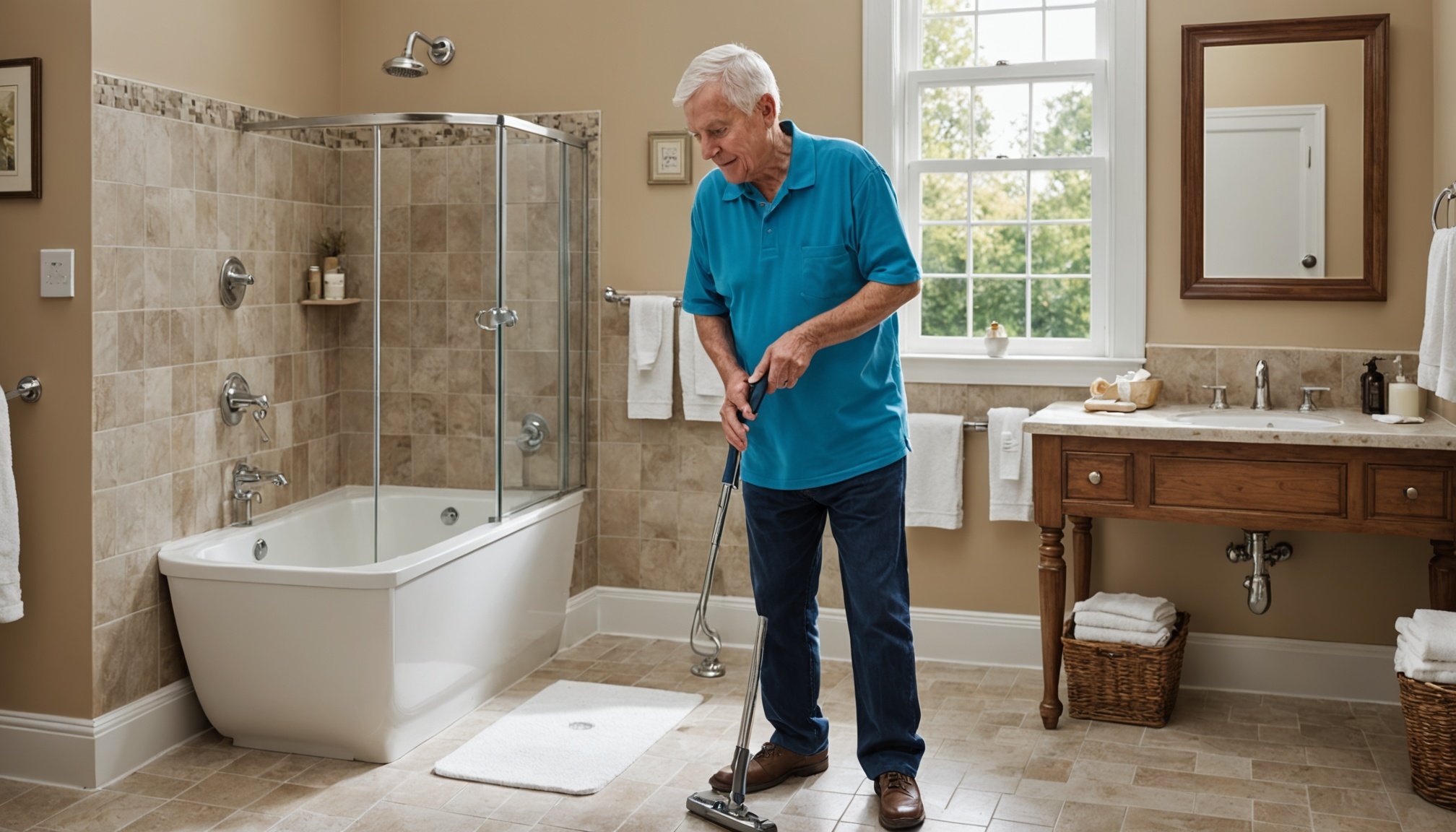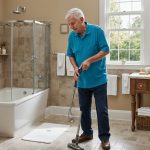Introduction to Bathroom Safety for Seniors
The importance of bathroom safety for seniors over 75 is undeniable. As people age, physical challenges become more prevalent, increasing the risk of accidents, especially in the bathroom. Understanding common bathroom hazards can help mitigate these risks. These hazards include wet and slippery floors, hard-to-reach cabinets, and bathtubs without support, which can all contribute to falls. Such incidents are not only physically detrimental, possibly leading to fractures or head injuries, but also psychologically impactful, causing anxiety about using the bathroom independently.
To enhance bathroom safety, various modifications are available. Installing grab bars near the toilet and shower, using non-slip mats, and ensuring adequate lighting can significantly reduce the risk of accidents. Accessible storage options are also crucial, giving seniors easy access to toiletries without overreaching. Additionally, walk-in bathtubs or showers with seating offer enhanced stability and comfort. For seniors over 75, these modifications are not just recommendations but essential steps to ensure safety and maintain independence in daily activities. Emphasizing these practical solutions can greatly improve the quality of life for seniors, allowing them to use the bathroom with confidence and ease.
Have you seen this : Boosting Brain Health: The Role of Social Engagement in Preventing Cognitive Decline for Seniors Aged 70 and Above
Essential Bathroom Modifications
Creating a safe bathroom environment is vital for individuals with mobility issues or those looking to prevent accidents.
Grab Bars Installation
Grab bars serve a crucial role in preventing falls by offering stable support. Installing grab bars in strategic locations, such as near toilets and showers, enhances bathroom safety significantly. There are various types, including vertical, horizontal, and angled bars. Proper installation is key; bars should be mounted at heights conducive to easy reach without straining.
Also read : Empowering Seniors Over 70: Essential Functional Fitness Strategies for Thriving Independence
Non-Slip Flooring Solutions
Choosing the right materials for non-slip surfaces is essential. Options like textured tiles, vinyl, or rubber flooring provide excellent grip, significantly reducing slip risks. It’s crucial not only to focus on material but also on texture and design, ensuring ample friction. Regular maintenance, such as cleaning and inspecting for wear, ensures these surfaces remain effective.
Raised Toilet Seats
Raised toilet seats offer significant advantages for individuals with limited mobility. They make transferring to and from the toilet easier and safer. Options range from locking to cushioned varieties, catering to different needs and comfort levels. Selecting the right height is important for ensuring usability and safety.
Curb-less Showers
Curb-less showers are perfect for easy accessibility. They eliminate the need to step over a ledge, reducing trip hazards. Key design considerations include efficient water drainage to prevent pooling. Additional features like built-in seating can further enhance shower safety and convenience.
Additional Safety Features
Implementing safety measures in the bathroom is crucial to prevent accidents such as slips and falls, especially for seniors.
Shower and Bath Mats
Selecting non-slip mats is integral for ensuring safety in the shower and bath areas. Effective mats should provide a firm grip, be water-resistant, and made of durable material to prevent slips. Installing them correctly involves placing them on thoroughly cleaned, dry surfaces to ensure maximum adhesion. Regular maintenance is also vital; washing mats to prevent mold accumulation not only ensures hygiene but maintains their slip-resistant properties.
Adequate Lighting Solutions
The importance of adequate visibility in the bathroom cannot be overstated. Proper illumination reduces the risk of accidents by ensuring all hazards are visible. Different lighting fixtures can be considered, including ceiling lights, vanity lights, and night lights. For seniors, smart lighting options, adjustable by voice or remote control, offer ease of use and further enhance safety by ensuring consistent visibility.
Emergency Call Systems
Various emergency response systems are available, tailored to different needs. Key factors in choosing a system include ease of use, reliability, and compatibility with other devices. Integrating these systems into a smart home allows for quick access and immediate response, offering peace of mind through enhanced safety accessibility.
Practical Tips for Implementation
Implementing modifications in a home for seniors requires strategic planning. A step-by-step guide can simplify this process, ensuring that no critical elements are overlooked. Start by conducting a thorough evaluation of the current living space to identify safety hazards and accessibility issues. This initial step will provide a clear picture of the necessary modifications.
Once the assessment is complete, involve seniors in the decision-making process. Personalization is key to creating a space that is not only safe but comfortable and suited to individual preferences. Seniors can offer insights into their daily routines, preferences, and specific needs, contributing effectively to more tailored solutions.
Incorporating a budget into the planning phase is critical to understanding the potential costs involved. From ramps and handrails to more significant transformations like wider doorways or bathroom renovations, expenses can vary widely. It’s crucial to research potential funding options, such as government grants or community programs, which could alleviate some financial burdens.
In summary, successful home modifications for seniors entail a clear, methodical approach. By considering safety assessments, personalization through senior involvement, and effective budgeting, you can ensure a smoother transition towards a safer and more accessible living space.
Resources and Support
Accessing the right resources and support is crucial when considering bathroom safety modifications, especially for caregiver support and elderly individuals.
Professional Help
Knowing when to consult an expert can prevent costly mistakes. Experts are generally needed when the modifications involve structural changes, plumbing, or electrical work. Different types of professionals specialize in bathroom safety, including occupational therapists, home renovation contractors focusing on accessibility, and elder care specialists. When searching for these services, it is vital to find reputable contractors. Look for those with certifications or affiliations with professional organizations. Recommendations from friends or online reviews can also be invaluable.
Community and Online Resources
Numerous organizations provide assistance and information for bathroom safety improvements. Non-profits and government programs often offer guides and sometimes even financial assistance. Joining online forums and groups for caregiver support can expand your knowledge base. Engaging with these communities can offer insights from shared experiences. Don’t overlook helpful websites and guides; they can walk you through step-by-step modifications that are affordable and effective.
Safety Statistics and Research
Understanding the current statistics on falls in the elderly population can underscore the importance of these modifications. Studies indicate that most falls occur in bathrooms, affecting about one-third of seniors annually. Research on bathroom modifications shows promising results, such as significant reductions in fall-related injuries, demonstrating how these changes effectively improve safety outcomes.
Conclusion
Bathroom safety modifications are paramount for ensuring the well-being of seniors. Such changes can significantly reduce the risk of accidents that are common in potentially hazardous areas. By installing grab bars, non-slip mats, and adequate lighting, these spaces can be transformed into safer environments. It’s essential to remember that these adjustments not only protect against mishaps but also foster independence.
Taking proactive steps towards enhancing bathroom safety reflects thoughtful planning and genuine concern for quality of life. Seniors, who often face mobility challenges, greatly benefit when these modifications are in place, as they promote a sense of security and self-reliance. Any step taken to adapt the bathroom environment is a step towards making daily activities more manageable and stress-free.
With safety modifications, everyday activities become less of a burden and more of an opportunity for continued independence and dignity. Families and caregivers are encouraged to explore these options and take action. Investing in these changes is not just about preventing falls but also about investing in peace of mind and improving quality of life.
Ultimately, with appropriate adjustments, seniors can enjoy increased comfort and confidence, turning the bathroom into a space that supports their needs rather than one that presents challenges.











